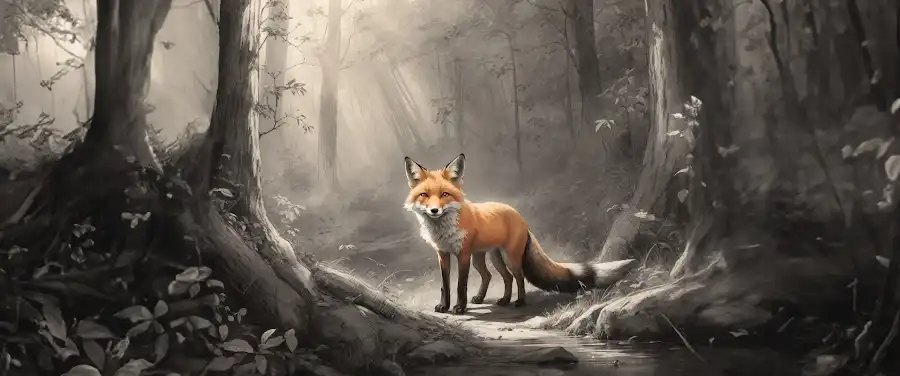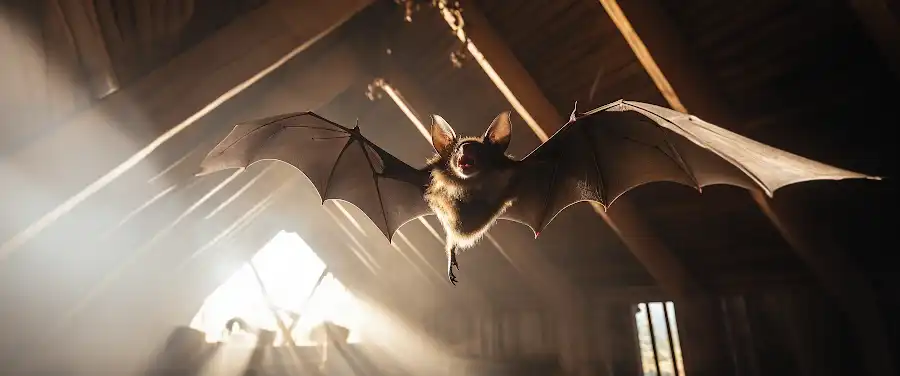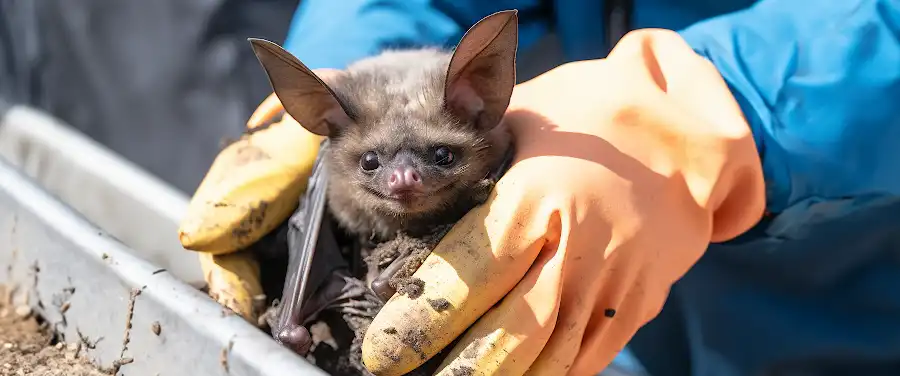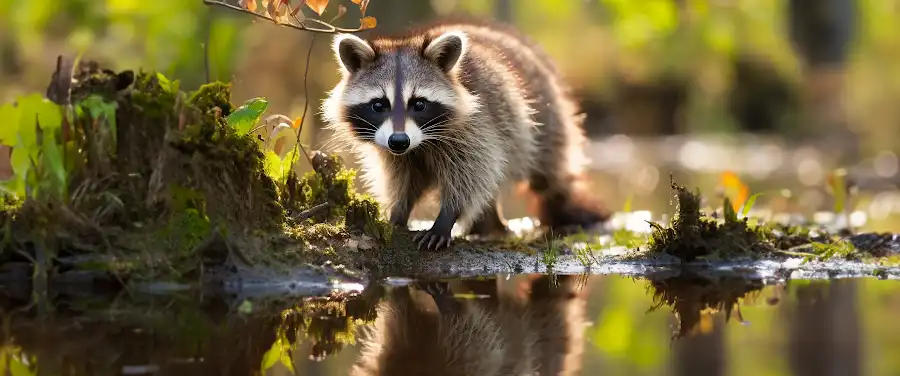
Raccoons, nature’s adorable creatures of the night. Often glimpsed through the shimmering moonlight as they sneakily rummage through our leftovers, these masked bandits have, over the years, sparked our curiosity without fail. While you may have spotted the infamous Procyon Lotor —that’s “raccoon” to you and me—feasting on a late-night snack in your trash bin, their enigma extends far beyond their midnight food adventures. Could there be more to these charmingly mischievous beings than their reputation as nature’s junk-food fanatics?
Now, we all know raccoons for their peculiar traits; their adorably masked face, those nimble hands, the artful tactics for scavenging, and of course, their gourmet palate exclusively chosen by the neighborhood trash cans. Yet, these unique attributes barely scratch the surface of the complex and captivating world of the raccoon. Are we missing out on the tale of their journey? The drama that unfolds over their lifespan? The gastronomic preferences that dictate their daily life?
As you tag along in this enlightening journey into the raccoon kingdom, prepare yourself to uncover the lesser-known facts about the life of these intriguing creatures. Discover what lurks beneath the cute exterior, as we string together various stages in the lifecycle. Let’s delve into their culinary quirks and unravel how their diet intertwines with their unique lifestyle. So, brace yourself, because the subversive exploits, lifestyle, and the seemingly bizarre food preferences of our nocturnal visitor Procyon Lotor, promise an exciting exploration. Up next, we’ll venture further into the classification of raccoons, to better understand where they belong in the grand scheme of Mother Nature.
Where Can You Find Raccoons in the Wild?
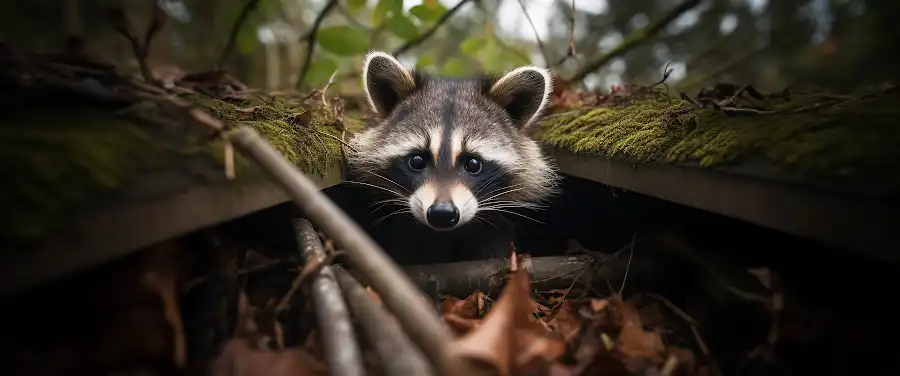
Raccoons, or Procyon Lotor, are no strangers to the animal kingdom, but where exactly can you find these creatures in the wild? Raccoons in the wild are adaptive and resilient. They inhabit an array of natural habitats such as forests, mountainous areas, marshlands, and even coastal regions. There is a broad raccoon distribution across the continents, primarily focusing on North America, Europe, and parts of Asia.
This intricate web of habitats paints a vivid picture, allowing us to explore the tenacious lifestyle of these omnivores. Now, when we talk about raccoons in urban areas, there’s a lot to uncover, so let’s delve right in.
Why Do Raccoons Live in Urban Areas?
The city life has a certain charm that everyone, including raccoons, find irresistible. These intelligent creatures have learned that residential areas offer an endless supply of food and shelter making their urban adaptation almost seamless. In fact, the impact of urbanization on raccoons has led them to become commonplace in our backyards, parks, and city streets. They’re termed as urban raccoons, signifying their ability to thrive amidst human settlements.
While the city offers a banquet of easy food, it also brings about a radical alteration in their natural behavior. This shift can lead to conflicts between humans and raccoons, raising significant questions about our urban ecosystems.
Here is a succinct summary of the geographical spread of raccoons:
| Habitat | Characteristics | Geographical Spread |
|---|---|---|
| Wild | Forests, marshlands, mountainous and coastal areas | Primarily North America, and scattered pockets in Europe and Asia |
| Urban | Residential areas, city parks, streets | Across major cityscapes world-wide |
These discussions pave the way towards understanding the life cycle of raccoons, which we’ll explore in the following section, “How does the raccoon life cycle work?“. Adjusting to life amidst humans necessitates changes in every stage of the life cycle, from birth to maturity. This narrative offers an opportunity to examine these creatures through different lenses, from their natural habitats to the urban jungles they now call home. We invite you to continue this journey with us, unearthing the secrets of raccoons, nature’s Procyon Lotor.
How Does the Raccoon Life Cycle Work?
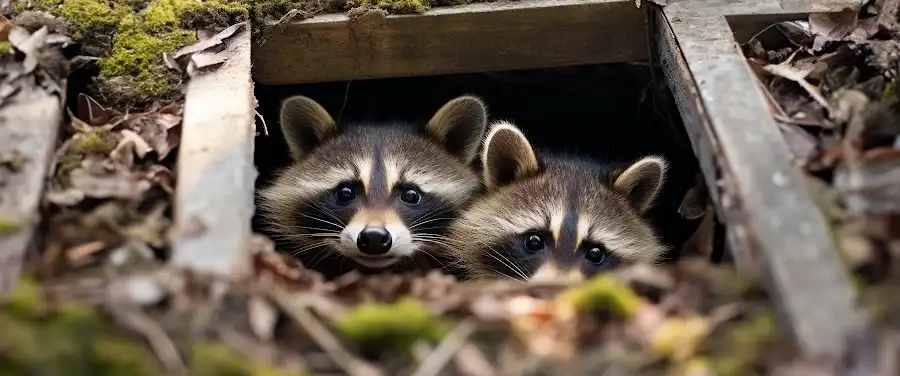
Life in the wild can be quite fascinating, and few creatures exemplify this as well as the raccoon (Procyon Lotor). Let’s take a trip with Mother Nature, uncovering the various stages in the raccoon life cycle, highlighting their life span, and gently lifting the curtain obscuring their ageing process.
Raccoons embark on their life journey as blind and deaf newborns, utterly reliant on their mother’s care. For the first few weeks, the baby raccoons, also amusingly referred to as “kits,” stay in the den while the mother gathers food. After about two months, these young explorers start venturing out to learn the art of survival. Raccoons mature quickly, with females ready to mate at about a year old and males somewhat later. The typical raccoon life span ranges between two to three years, but some have been known to live up to 20 years in the wild!
What Are the Mating Habits of Raccoons?
The raccoon mating season is another exciting aspect of their lifecycle. Mating typically occurs in early spring, from January to February. Ear-piercing vocalizations often mark the mating period, akin to an orchestra in the wild.
Once pregnant, female raccoons find a safe den to give birth, usually hidden in tree hollows or burrows. After an approximately 65-day gestation period, the female gives birth to two to five kits.
Raccoons surprise us with their parental care; it’s not just about survival of the fittest here! The mother raccoon plays the leading role, nursing, nurturing, and fiercely protecting her kits, teaching them the ropes for about a year until they are fully grown and can fend for themselves.
How Do Baby Raccoons Develop?
From birth, baby raccoons journey towards adulthood is marked by steady growth and numerous challenges. The first year of a raccoon’s life is filled with rapid development and learning.
By eight weeks, the young raccoons have started to climb and explore beyond their den, their sights set on dominating the nights! However, this young age brings dangers of predators, prey shortages, or even harsh weather. Despite the odds, between their mother’s teaching and their inherent survival instincts, they strive and often succeed.
Let’s digest the raccoon life cycle in a more comprehensive way with this table:
| Raccoon Life Cycle Stages | Age | Description |
|---|---|---|
| Birth | Day 0 | Newborn raccoons are blind and deaf |
| Youth | 2 Months | Young raccoons begin venturing outside their den |
| Adolescence | 1 Year | Raccoons reach sexual maturity |
| Adulthood | 2-3 Years | Raccoons are fully grown and fend for themselves |
| Old Age | Over 20 Years | Long-lived raccoons in the wild reach this age |
As we have seen, the lifecycle of a raccoon, while challenging, is a captivating marvel of nature. With each stage, from birth to adulthood, they exhibit remarkable survival skills and adaptability. Understanding the raccoon life cycle, mating habits, and development of baby raccoons, undoubtedly deepens our appreciation for these fascinating creatures.
Are you curious about what fuels these little critters through their growth? Brace yourself, as we dive into the diverse diet of the raccoons, next!
To give you an idea of the average costs and types of damage associated with rodent infestations, have a look at the following table:
What Do Raccoons Eat?- Overview of Raccoon’s Omnivorous Diet
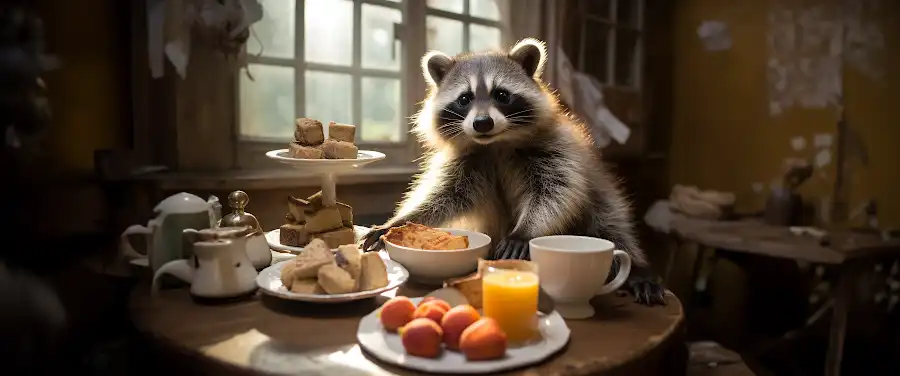
Friendly and playful, yet cunning, raccoons are one of America’s most beloved and misunderstood mammals. Found across North America, these cheeky creatures have adapted to almost every environment. But have you ever wondered what a raccoon eats? If you have, you’re not alone!
Raccoons are pretty adaptable when it comes to their diet, making them omnivorous creatures. From fruits and plants to small animals and insects, raccoons will eat almost anything they get their tiny paws on! In fact, their love for a varied diet can often lead them to open garbage containers or sneak into homes. That’s why raccoon diet and raccoon foraging habits are always topics of interest!
How Do Seasons Affect Raccoons’ Diet?
Just as humans crave different foods depending on the time of year, so too do raccoons. Seasonal changes in the raccoon diet are quite common. In the spring, raccoons might enjoy feasting on fruit, berries or insects, while in the winter their diet leans more towards meat and eggs.
This dietary variation is also influenced by the weather and climate of the area. For example, raccoons in colder regions may need to store more fat to survive harsh winters, thus their food preferences shift accordingly. Truly, the weather and climate indeed impact the raccoon’s choices when it comes to what, when, and where to eat!
How Do Raccoons Search for Food?
Raccoons are pretty sneaky when it comes to finding food. Their hunting methods are guided by their hands and superior senses. Did you know raccoons’ hands have the same sensory receptors as human hands? These deft hands aid their examination of objects and searching for food.
But, it’s not just their hands that guide them during dinnertime. These intelligent mammals also rely heavily on their acute sense of sight and hearing. It’s what makes them great foragers and successful hunters. Their extraordinary ability to sense objects and living beings is simply impressive!
Indeed these raccoon hunting methods, including their keen senses and tactile dexterity, give these clever critters a competitive edge when it comes to finding food. Fascinated to learn more? This National Geographic article provides more insights into raccoons’ dietary habits.
The world of raccoons is truly fascinating, with their complex life cycles, diverse diets, and intelligent hunting strategies. As omnivores, raccoons have a broad and flexible diet that is influenced by multiple factors like the seasons, weather, geography, and availability of food. Their food procurement methods, aided by their advanced senses and nimble hands, are yet another testimony to their adaptability and resourcefulness.
Now that we’ve uncovered the secrets of the raccoon diet, let’s move on with our journey to discover more about how raccoons interact with their surroundings.
Conclusion
In wrapping up our exploration into the secrets of Procyon Lotor, better known as the raccoon, we’ve shed light on their intriguing life cycle and varied diet. These curious creatures’ behaviors have intrigued us, regaled us with their adaptability and penchant for survival, and enlightened us about their role in our ecosystem. This vibrant narrative journey into the world of Procyon Lotor hasn’t only been about uncovering their secrets but also about appreciating their incredible adaptability and resilience.
Nothing compares to watching the engaging spectacle of raccoons foraging for food or observing their unique behavior. Documenting these behaviors, alongside their life cycle and diet, is key to understanding these creatures and preserving our wildlife. Recognizing the value of our experiences with raccoon populations, their life cycles, and dietary habits, brings into focus the value and importance of wildlife conservation efforts worldwide.
You may think that raccoons are just cute animals with a knack for scavenging, but there is so much more to these animals than meets the eye. Every new tidbit we learn about their life cycle and diet sheds light on how raccoons adapt and evolve, teaching us to better appreciate these often misunderstood creatures.
So, with all this in mind, will we conclude that raccoons are merely pesky inhabitants of our cities, or will we now see them for what they are – nature’s adaptable, resourceful creatures that continually surprise us with their tenacity and survival tactics? The choice is yours. In either case, it’s vital that with every raccoon sighting or encounter, we are reminded of the intricate beauty and complexity of our earthly cohabitants, and how it places value on our human responsibility to protect and preserve them.
Remember, the world of a raccoon is a rich tapestry of survival, adaptability, and intelligence. Unraveling their secrets not only satisfies our curiosity but also strengthens our bond and respect towards nature and its multitude of inhabitants.

